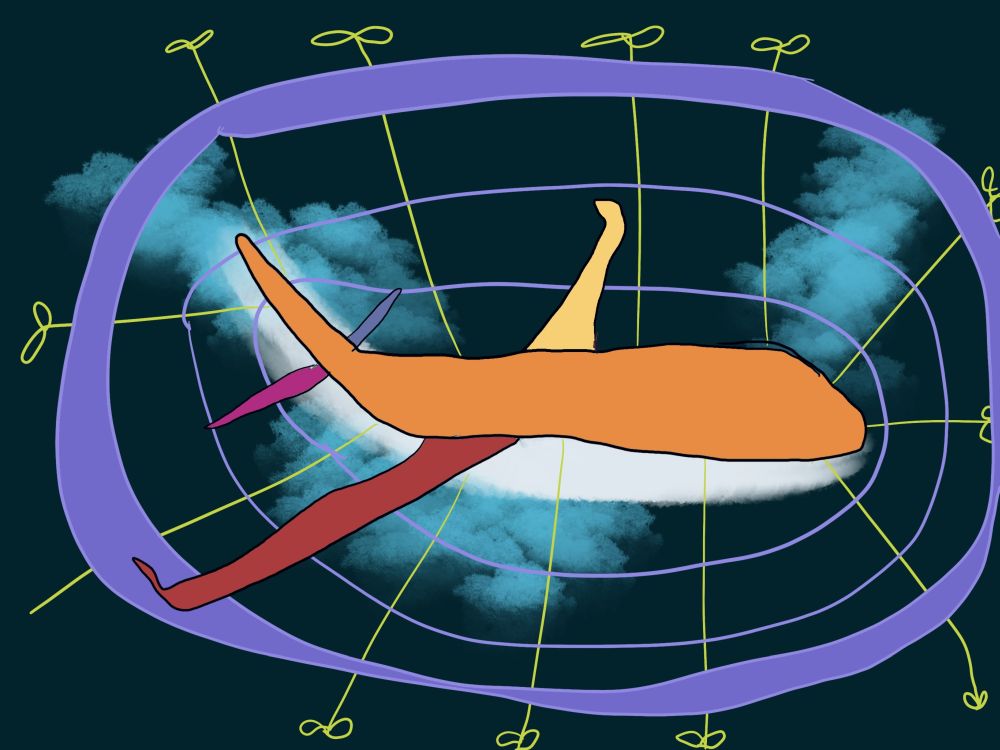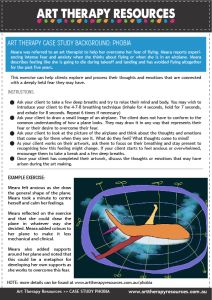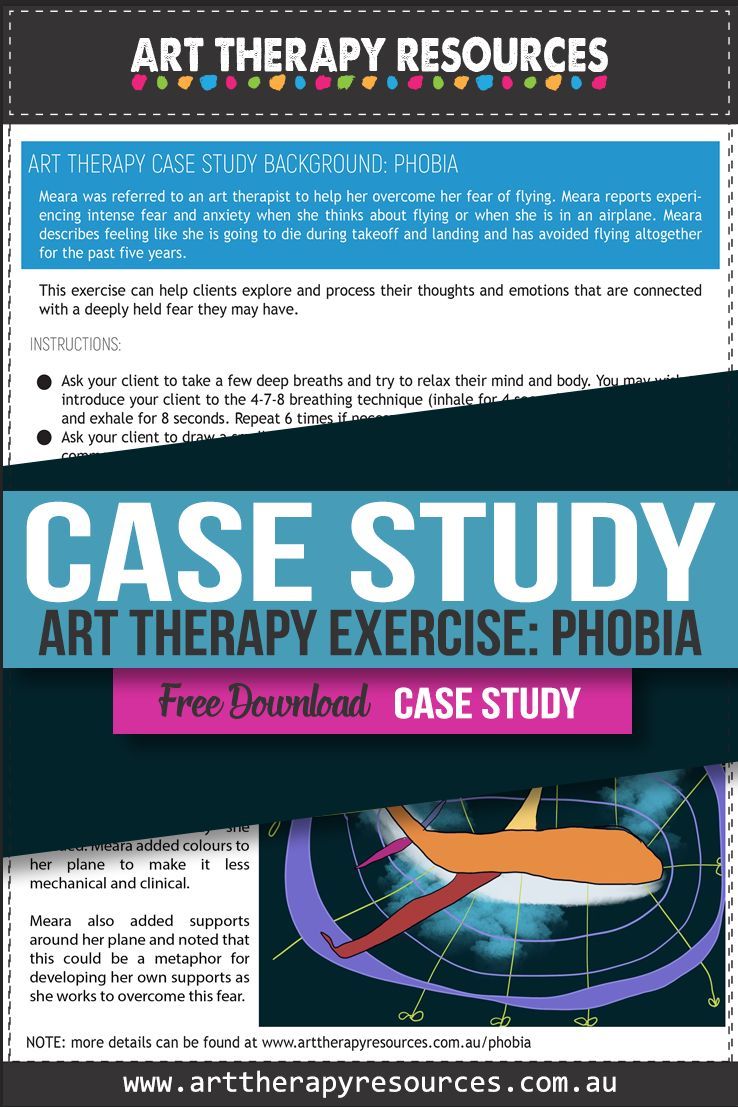THIS POST INCLUDES:
- Art Therapy and Phobias
- About the Client
- Art Therapy Exercise
- Client Insight and Outcomes
- Disclaimer
- FREE DOWNLOAD Art Therapy Exercise
ART THERAPY AND PHOBIAS
Phobias are irrational and intense fears of certain objects, situations, or activities. While everyone experiences fear at some point in their lives, phobias are different in that they are persistent, excessive, and interfere with daily functioning. The psychology behind phobias is complex and involves a combination of biological, environmental, and psychological factors.
One theory suggests that phobias are learned through classical conditioning, where a person associates a specific object or situation with a negative experience or emotion. For example, if someone has a traumatic experience with dogs, they may develop a phobia of dogs. Another theory suggests that phobias are the result of evolutionary adaptations, where certain objects or situations that were once threats to human survival (such as spiders or heights) have become ingrained in our genetic makeup.
Psychological factors also play a role in the development of phobias. Some individuals may have a genetic predisposition to anxiety or may have experienced childhood trauma that increases their likelihood of developing a phobia. Additionally, phobias may be a way of coping with underlying emotional issues, such as anxiety, depression, or low self-esteem. By focusing on a specific fear, a person may be able to avoid dealing with these underlying emotional issues.
Cognitive-behavioral therapy (CBT) is a common treatment for phobias that is based on the theory that our thoughts, behaviors, and emotions are interconnected. CBT aims to change the negative thoughts and behaviors associated with phobias through exposure therapy, where a person gradually confronts their fear in a safe and controlled environment. Through this process, individuals can learn to reframe their thoughts and develop coping strategies to manage their phobia.
The psychology behind phobias is complex and involves a combination of biological, environmental, and psychological factors. While phobias can be debilitating, there are effective treatments available that can help individuals overcome their fears and improve their quality of life.
CHARACTERISTICS OF PHOBIAS
Phobias are characterized by an irrational and excessive fear of a specific object, situation, or activity. Some common characteristics of phobias include:
- INTENSE FEAR: Individuals with phobias experience an intense and overwhelming fear when faced with the object or situation that triggers their phobia. This fear can be so strong that it interferes with their daily life.
- AVOIDANCE BEHAVIOUR: People with phobias often go to great lengths to avoid the object or situation that triggers their fear. For example, someone with a phobia of flying may refuse to travel by plane, even if it means missing important events.
- TRIGGERING STIMULI: Phobias are triggered by specific stimuli, such as spiders, heights, or social situations. These stimuli can be real or imagined and may vary in intensity depending on the individual.
- UNREASONABLE RESPONSE: The fear and anxiety associated with phobias are often out of proportion to the actual danger posed by the triggering object or situation.
- DISTRESS AND IMPAIRMENT: Phobias can cause significant distress and impairment in daily life. Individuals may experience physical symptoms such as sweating, trembling, and increased heart rate when confronted with their phobia. They may also experience social or occupational impairment due to their avoidance behavior.
- DURATION: Phobias typically persist for six months or longer and can last for years or even a lifetime if left untreated.
Phobias are marked by an intense and persistent fear of a specific object or situation, avoidance behavior, and impairment in daily life. While phobias can be debilitating, effective treatments such as exposure therapy and cognitive-behavioral therapy can help individuals manage their fears and improve their quality of life.
HOW ART THERAPY CAN HELP WITH PHOBIAS
Art therapy uses creative expression as a means of promoting healing and self-discovery. It can be a valuable tool for individuals with phobias, as it provides a non-threatening way to explore and express their fears. Here are some ways in which art therapy can help with phobias:
- EMOTIONAL EXPRESSION: Creating art can help individuals with phobias to express their emotions in a non-verbal way. By putting their fears and anxieties into visual form, individuals can gain a better understanding of their emotions and work through them in a safe and supportive environment.
- EXPOSURE THERAPY: Art therapy can be used as a form of exposure therapy, where individuals are gradually exposed to the object or situation that triggers their phobia. For example, someone with a fear of spiders may be asked to draw or paint a picture of a spider. This process can help to desensitize individuals to their phobia and reduce the intensity of their fear.
- RELAXATION AND STRESS REDUCTION: Art therapy can also be a relaxing and stress-reducing activity. By engaging in a creative process, individuals can reduce their overall levels of anxiety and tension. This can be especially beneficial for individuals with phobias, as anxiety and stress can exacerbate their symptoms.
- SELF-REFLECTION: Through the creation of art, individuals with phobias can gain a better understanding of themselves and their fears. Art can provide a way to explore and process complex emotions and experiences that may be difficult to articulate through words alone.
- SELF-ESTEEM AND CONFIDENCE BUILDING: Art therapy can be a powerful tool for building self-esteem and confidence. As individuals with phobias work through their fears and create something meaningful, they can develop a sense of accomplishment and pride in their abilities.
Art therapy can be a valuable form of treatment for individuals with phobias. By providing a creative and non-threatening way to explore and express their fears, art therapy can help individuals to manage their symptoms and improve their overall quality of life.
ABOUT THE CLIENT
- Name: Meara
- Age: 32
CURRENT CLIENT ISSUES:
Meara was referred to an art therapist to help her overcome her fear of flying. Meara reports experiencing intense fear and anxiety when she thinks about flying or when she is in an airplane. Meara describes feeling like she is going to die during takeoff and landing and has avoided flying altogether for the past five years.
ART THERAPY EXERCISE
This exercise can help clients explore and process their thoughts and emotions that are connected with a deeply held fear they may have.
INSTRUCTIONS:
- Ask your client to take a few deep breaths and try to relax their mind and body. You may wish to introduce your client to the 4-7-8 breathing technique (inhale for 4 seconds, hold for 7 seconds, and exhale for 8 seconds. Repeat 6 times if necessary)
- Ask your client to draw a small image of an airplane. The client does not have to conform to the common understanding of how a plane looks. They may draw it in any way that represents their fear or their desire to overcome their fear.
- Ask your client to look at the picture of the airplane and think about the thoughts and emotions that come up for them when they see it. What do they feel? What thoughts come to mind?
- As your client works on their artwork, ask them to focus on their breathing and stay present to recognising how this feeling might change. If your client starts to feel anxious or overwhelmed, encourage them to take a break and a few deep breaths.
- Once your client has completed their artwork, discuss the thoughts or emotions that may have arisen during the art making.
CLIENT INSIGHT AND OUTCOMES
Meara felt anxious as she draw the general shape of the plane. Meara took a minute to centre herself and calm her feelings.
Meara reflected on the exercise and that she could draw the plane in whatever way she decided. Meara added colours to her plane to make it less mechanical and clinical.
Meara also added supports around her plane and noted that this could be a metaphor for developing her own supports as she works to overcome this fear.

DISCLAIMER
This case study represents a snapshot of the client’s progress in treatment. The exercise in this article could be used as written or as a guide for new and original tasks developed by the Art Therapist. Responsibility for treatment resides with the individual therapist who understands their clients specific needs. The art therapy exercise should not be viewed as a pre-defined directive on how to treat a client that presents with a specific range of problems.This art therapy exercise will help build a database of knowledge to draw upon when helping your client. Art Therapy is associated with psychotherapy techniques, however each therapist often approaches therapy with their own foundation of psychological interventions, whether it be psychotherapy, CBT, DBT or other methods.
FREE DOWNLOAD: Art Therapy Exercise
Download the FREE Art Therapy Exercise based on the above Case Study. The free download includes instructions for the art therapy exercise, along with an example of the art therapy exercise.

BUILD YOUR ART THERAPY REFERENCE MATERIALS:
Pin this image to your Pinterest board.

SHARE KNOWLEDGE & PASS IT ON:
If you’ve enjoyed this post, please share it on Facebook, Twitter, Pinterest. Thank you!
